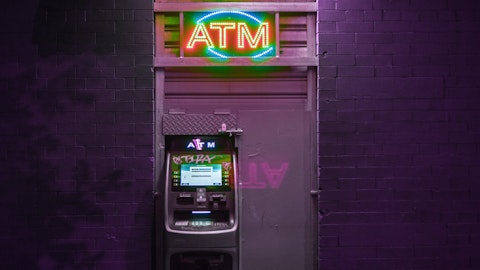East West Bancorp, Inc. (NASDAQ:EWBC) Q1 2023 Earnings Call Transcript April 20, 2023
East West Bancorp, Inc. beats earnings expectations. Reported EPS is $2.27, expectations were $2.2.
Operator Good day. And welcome to the East West Bancorp First Quarter 2023 Earnings Conference Call. All participants will be in a listen-only mode. [Operator Instructions] After today’s presentation, there will be an opportunity to ask questions. [Operator Instructions]Please note this event is being recorded. I would now like to turn the conference over to Diana Trinh, Vice President and Investor Relations Officer. Please go ahead.Diana Trinh Thank you, Betsy. Good morning. And thank you everyone for joining us to review the financial results of East West Bancorp’s first quarter 2023. Joining me today are Dominic Ng, Chairman and Chief Executive Officer; and Irene Oh, Chief Financial Officer.This call is being recorded and will be available for replay on our Investor Relations website.
We will be referencing a slide deck during the call that is available on our Investor Relations site.Management may make projections or other forward-looking statements, which may differ materially from the actual results due to a number of risks and uncertainties and management may discuss non-GAAP financial measures.For a more detailed description of the risk factors and a reconciliation of GAAP to non-GAAP financial measures, please refer to our filings with the Securities and Exchange Commission, including the Form 8-K filed today.I will now turn the call over to Dominic.Dominic Ng Thank you, Diana. Good morning. Thank you everyone for joining us for our earnings call. I will begin the review of our financial results on slide three of our presentation.
This morning, we reported first quarter 2023 net income of $322 million and diluted earnings per share of $2.27, excluding an impairment loss on the subordinate debt security of a failed bank, which was $7 million after tax. Adjusted net income was $329.5 million in the first quarter and adjusted earnings per share were $2.32. Adjusted earnings per share increased 40% year-over-year.Our profitability is industry leading. For the first quarter of 2023, our adjusted returns were 2.05% on average assets and 23% on average tangible common equity. First quarter pretax pre-provision profitability was 2.9%.Slide four presents a summary of our branch — of our balance sheet. As of March 31, 2023, total loans reached a record $48.9 billion, an increase of $697 million or 1% from December 31st.
First quarter average loan growth was likewise 1%.Average growth in residential mortgage and commercial real estate loans was partially offset by a modest decrease in average commercial and industrial loans. Total deposits were $54.7 billion as of March 31, 2023, a decrease of $1.2 billion or 2% from December 31st. First quarter average deposits were essentially unchanged from the fourth quarter.In the first quarter, time deposits grew due to successful branch-based Lunar New Year CD campaign. This was offset by declines in other deposit categories, which reflected customers seeking higher yields in a rising interest rate environment and the banking industry disruption in mid-March.Deposit growth is well diversified by deposit type and 33% of total deposits were in non-interest-bearing demand accounts as of March 31, 2023, our loan-to-deposit ratio was 89% as of March 31st.Turning to slide five.
As shown in exhibits on this slide, all of our capital ratios expanded quarter-over-quarter. As of March 31st, we had a common equity Tier 1 ratio of 13.06%, up 38 basis points quarter-over-quarter, a total capital ratio of 14.5%, up 50 basis points quarter-over-quarter and a tangible common equity ratio of 8.74%, up 8 basis points quarter-over-quarter, our capital ratios are some of the highest among regional banks.Also on this slide, our pro forma capital calculations as of March 31, 2023. The key takeaway is that our capital is very strong. The slide we provided pro forma capital ratios adjusting for available for sale and held to maturity security marks that are not already included in the capital ratios and also for on- and off-balance sheet allowance not already included in the capital ratios.Over the quarter, our book value per share grew 5% and our tangible book value per share increased 6%.

nick-pampoukidis-t-UV1rZqPuY-unsplash
West Board of Directors has declared second quarter 2023 dividends for the company’s common stock. The quarterly common dividend of $0.48 will be payable on May 15, 2023 to stockholders of record on May 1, 2023.Moving on to a discussion of our loan portfolio, beginning with slide six. As of March 31, 2023, C&I loans outstanding were $15.6 billion, down only $69 million or 0.4% from prior quarter end and up 5% year-over-year. As shown on this slide, our C&I portfolio continues to be well diversified by industry and sector. Greater China loans increased 1% linked-quarter to $2.2 billion as of March 31, 2023.Slide seven and eight show the details of our commercial real estate portfolio, which is well diversified by geography and property type, and consists of low loan-to-value loans.
Total commercial real estate loans were $19.4 billion as of March 31, 2023, up 2% from December 31st and up 14% year-over-year. The quality of our loan portfolio remains very strong. However, given the attention on CRE, we have added more details about our office and retail commercial real estate loans on slide nine and slide 10.You can see on slide nine, our office commercial real estate portfolio is very granular with few large loans. We have only seven loans totaling $271 million that are greater than $30 million in size. The weighted average loan-to-value of our office commercial real estate portfolio is a low 52% and the loan-to-value is consistently low across long-sized segment. Portfolio is well diversified by geography with limited exposure to downtown and central business district loans.On slide 10, you can see that our retail commercial real estate portfolio is also very granular with few large loans.
We have only seven loans totaling $268 million, which are greater than $38 million in size.The weighted average loan-to-value of our commerce — retail commercial real estate portfolio is a low 48% and the loan-to-value is also consistently low across retail segment. The portfolio is well-diversified geographies and the footprint largely reflect our branch network.In slide 11, we provide details regarding our residential mortgage portfolio, which consists of single-family mortgages and home equity lines of credit. Our residential mortgage loans are primarily originated through our branch network. I would highlight that 82% of our HELOC commitments were in a first leading position as of March 31, 2023.Financial mortgage loans totaled $13.8 billion as of March 31st, up 3% from December 31st and up 19% year-over-year.
We added a new slide to provide more information about our granular diversified deposit base.Slide 12 demonstrates our deposit mix by segment and also industry for commercial deposits. Deposits totaled $54.7 billion as of March 31, 2023, a decrease of 2% quarter-over-quarter and less than 0.5% year-over-year.Now over 550,000 deposit accounts at East West and our average commercial deposit account size is approximately 375,000 and our retail branch-based consumer deposits, which totaled 33% of our deposits have an average size of approximately 40,000.Commercial deposits are well diversified by industry. Our largest commercial deposit industry segment at 7% is real estate property investment and management. These deposits are predominantly thousands of operating accounts for individual properties that are commercial real estate customers owned.As of March 31st, out of our $52.5 billion in domestic deposits, insured or otherwise collateralized deposits were $29.6 billion and domestic uninsured deposit ratio improved to 44%, down from 50% as of December 31, 2022.During the industry disruption in mid-March, our associates have worked with customers to expand their FDIC insurance coverage, primarily through the utilization of fully insured sweep programs.
And as of yesterday, April 19, 2023, the domestic uninsured deposit ratios improved to 41%.We will now turn the call over to Irene for a more detailed discussion of our securities portfolio, liquidity management, asset quality and income statement. Irene?Irene Oh Thank you, Dominic. I will start with a discussion of our securities portfolio and liquidity management strategy on slide 13. At March 31st, our securities available for sale or AFS had a fair value of $6.3 billion with a weighted average spot yield of 3.25% and a duration of approximately four years. We purchased few AFS securities in the first quarter. Gross unrealized losses on this portfolio were 11% of amortized cost as of March 31st, will be reflected in tangible common equity as part of AOCI.On March 31st, our securities held-to-maturity or HTM had an amortized cost of $3 million and a weighted average spot yield of 1.73% with the duration of approximately eight years.
We have the ability and intent to hold these securities until maturity. With unrealized losses on our HTM securities were 16% of amortized costs as of March 31.At the time of the transfer of these securities from AFS to HTM in the first quarter of 2022, $138 million of the unrealized losses were included in AOCI and are reflected in equity. As the remainder of the unrealized losses on HTM were to be treated similarly to AFS, our tangible common equity would still be a very strong 8.37% as of March 31st.We took many actions in response to the recent banking industry disruption. First, we increased our on-balance sheet liquidity. Our cash and cash equivalents increased 70% to $5.9 billion as of March 31st, up from $3.5 billion as of December 31st.
This increase was primarily funded with $4.5 billion in borrowings to the Bank Term Funding Program at a cost of 4.37%. Thus, the on balance sheet liquidity has provided a positive carry and contribution to NII.Also, we swiftly added to our borrowing capacity by pledging additional assets for the Federal Reserve and the FHLB, San Francisco. Our total borrowing capacity plus cash and cash equivalents were $30.6 billion as of March 31st and is equivalent to 134% of our total uninsured and uncollateralized deposits. We have a long-standing approach to conservative liquidity management East West as an important component of our risk management practices.Moving on to asset quality metrics and components of our allowance for loan losses on slide 14 and 15.
The asset quality of our loan portfolio continues to be strong. Non-performing assets as of March 31st decreased to $93 million or 14 basis points of total assets, an improvement from $100 million or 16 basis points as of December 31st.Quarter-over-quarter, criticized loans increased 2% and the criticized loan ratio increased 1 basis point. Our allowance for loan losses increased to $620 million as of March 31st or 1.27% of loans, up from 1.24% as of year-end.During the first quarter, we recorded net charge-offs of $609,000 or 1 basis point of average loans annualized compared with net charge-offs of 8 basis points annualized in the fourth quarter.Looking [ph] the stability of our asset quality metrics, our loan charge-offs and the current macroeconomic forecast, we recorded a provision for credit losses of $20 million in the first quarter, compared to $25 million for the fourth quarter last year.Again, while asset quality remains strong and the current credit environment is benign, we continue to remain vigilant.
We are actively monitoring the loan portfolio and taking proactive measures to build our allowance for loan losses.We are performing ongoing deep dives into loan portfolio segments, for example, by commercial real estate property type and maturity year. We are showing up loans when appropriate by securing additional collateral, guarantees or paydowns from our borrowers.And now moving on to a discussion of our income statement on slide 16. As Dominic mentioned, this quarter we had a non-GAAP adjustment to our EPS of $0.05. Also, early in the year, we prepaid $300 million of repo liabilities that carried a weighted average interest rate of 6.74%.Amortization of tax credits and other investments in the first quarter was $10 million, compared with $65 million in the fourth quarter.
Variability in this line reflects timing of when tax credit investments closed. For the second quarter of 2023, we are currently estimating that the amortization of tax credit investments will be approximately $25 million.The first quarter effective tax rate was 23% compared with 20% for the 2022 full year. We currently anticipate that the effective tax rate for the full year of 2023 will also be 20%.I will now review the key drivers of our net interest income and net interest margin on slides 17 through 20, starting with the average balance sheet. First quarter average loan growth was 1% and first quarter average earning assets growth was 2%, reflecting the growth in loans and cash.Average deposits of $55 billion were essentially unchanged quarter-over-quarter, reflecting growth of $3 billion in CDs, offset by declines in other deposit accounts.
Declines in other deposit categories reflected ongoing customer preferences for higher yields, as well as the banking industry disruption in mid-March.Our average loan-to-deposit ratio was 88% in the first quarter and average non-interest-bearing demand deposits made up 36% of average deposits.Turning to slide 18. First quarter 2023 net interest income was $600 million, a decrease of 1% from the fourth quarter due to day count. Net interest margin of $3.96 compared by 2 basis points quarter-over-quarter. Equalizing for day count, the 2% quarter-over-quarter average earning asset growth more than offsets the 2 basis points of NIM contraction.Also, as you can see from the waterfall chart on this slide, NIM compression in the first quarter reflected the impact of higher interest-bearing funded costs and the funding mix shift partially offset by expanding asset yields.In April, we added $500 million notional value received fixed swap to augment the $3.25 billion of swaps and collars we added in 2022 to help preserve net interest income when they decrease.
This impact was about 8 basis points to NIM this quarter. NIM would have been 4.04% otherwise.Turning to slide 19. The first quarter average loan yield was 6.14%, an increase of 55 basis points quarter-over-quarter. As of March 31st, the spot coupon rate on our loans was 6.21%, compared with 5.92% as of year-end.In this slide, we also present the coupon spot yields for each major loan portfolio for the last five quarter ends. You will see the positive impact of rising interest rates on each loan portfolio as loans reprice. In total, 61% of our loan portfolio was variable rate as of March 31st, including 28% linked to prime rate and 27% linked to SOFR or LIBOR rate.I will also highlight that for our CRE loan customers, we have helped many of them hedge against rising rates due to the yields of swaps, caps and collars.
Fixed rate and synthetically fixed rate loans through the utilization of these derivatives are 65% of the total CRE book as of March 31st. While East West enjoys the benefit of asset sensitivity today, majority of our CRE customers are protected against rising debt service costs in a higher rate environment.Turning to slide 20. Our average cost of deposits for the first quarter was 160 basis points, up 54 basis points from the fourth quarter. Our spot rate on total deposits was 193 basis points as of March 31st, equivalent to 39% cumulative beta relative to the 475-basis-point increase in the target Fed funds rate since December 2021. In comparison, the cumulative beta on our loans has been 58% over the same time period.Moving on to fee income on slide 21.
Total non-interest income in the first quarter was $60 million, excluding the impairment of the aforementioned security, adjusted non-interest income in the first quarter was $70 million, up from $65 million in the prior quarter.Slide 22, first quarter non-interest expense was $218 million, excluding amortization of tax credits and CDI and debt extinguishment costs on the repo, adjusted non-interest expense was $204 million in the first quarter, up 6% sequentially, primarily driven by seasonal first quarter increases in comp and employee benefit expense.The first quarter adjusted efficiency ratio was 30% compared with 29% in the fourth quarter. Our adjusted pretax pre-provision income was $466 million in the first quarter and our pretax pre-provision return on assets was an industry-leading 2.90%.Next, outlook on slide 23.
For the full year 2023 compared to full year 2022, we currently expect year-over-year loan growth in the range of 5% to 7%, year-over-year net interest income growth in the range of 16% to 18% underpinning our net interest income assumptions is the forward interest rate curve as of March 31, 2023. Adjusted non-interest expense growth in the range of 8% to 9%, we expect our revenue and expense outlook to result in positive operating leverage.In terms of credit, for the full year of 2023, we expect to record a provision for credit losses in the range of $100 million to $120 million. The provision for credit losses for 2023 will largely be driven by change in the macroeconomic outlook and loan growth. Today, as the quality is excellent, we believe that the potential losses from any problem loans are limited.Finally, we expect that our effective tax rate for the full year will be approximately 20% based on about $150 million of tax credit investments for the year, excluding low income housing tax credits and an estimated related tax credit amortization of approximately $145 million for the full year.
There will be quarterly variability in the tax rate and the tax credit amortization due to the timing of tax credit investments placed in the service.With that, I will now turn the call back over to Dominic for closing remarks.Dominic Ng Thank you, Irene. In closing, East West has a sound business model and a healthy balance sheet. This is reflected in our granular deposit base and our diversified loan portfolio with strong asset quality. We operate with high capital ratios and we are well positioned to deliver strong earnings growth and industry-leading profitability despite the headwinds facing the banking industry.In 2023, our outlook is for attractive revenue growth and well-controlled efficiency. I wish to thank all our associates without whom our success would not be possible.
For over 50 years, our associates have strived to help our customers succeed and East West’s strong results are a reflection of their hard work and dedication.I will now open up the call to questions. Operator?
See also 11 Best Counter Cyclical Stocks To Buy Now and 15 Biggest Airplanes in the World in 2023.
Question-and-Answer Session Operator [Operator Instructions]
The first question today comes from Ebrahim Poonawala with Bank of America. Please go ahead.Ebrahim Poonawala Hey. Good morning.Dominic Ng Good morning.Irene Oh Good morning, Ebrahim.Ebrahim Poonawala I guess just one big picture question, Dominic. Clearly, I mean, I think, given what happened in March, I think, the question is business, commercial deposit customers a lot more sensitive around how they manage their excess funds or uninsured deposits, whichever way you want to look at it.
Has any of this changed in terms of how you strategically think about gathering deposits and what type of deposits you want on the balance sheet and how this may influence growth going forward?Dominic Ng Well, it really hasn’t changed too much, because we have always have a very strict principle in terms of we have got to run our balance sheet in a very prudent, conservative way and then no concentration in any particular industry, no concentration in any particular one single client and so forth. So you can see, despite the turmoil, well, we are down 2% after two weeks of chaos, the deposit down 2%.So it’s very different than other banks that may have a very, very high exposure and especially we need customer base. So our position is that so long that we don’t have overconcentration in any one particular client then you would not be taking a very, very big hit one way or the other.Now, obviously, if you look at for what happened for the last two weeks in March, customer’s behavior changed, particularly if you look at in the private equity sector or VC sector, the limited partners who may not be as familiar with the bank, we will probably talk to their general partner and ask that, hey, no, it is not a top-to-tail bank, maybe this is not necessary or they would rather take the money to some other treasury or some other sources just to make sure that they are parking their money in the same place when they have no ability to figure out how the bank’s financial performance are and so forth.Again, these are limited partners who do not have direct exposure or interaction with the banks.
So for those type of customers, there are two ways to handle it. One is that we provide additional financial information. So like we show our capital ratio. We show the borrowing capacity we just, I mean, 130% some odd higher than the insured deposits and we show the granular deposit base, consumer commercial 50,000 accounts, smaller balance are back that we show it to them, and then we can somewhat help convince even folks that have no exposure with East West bank we can get comfortable on that one way.The other way is the fully insured program like ICS and [inaudible]. So for — I mean, for convenience, sometimes we just sign them up for ICS, get data with. So they are now 100% insured, they don’t have to worry about it. And so we do combination multiple different ways, because for long-term, we want to continue to have more people to understand who East West are and then also through this kind of interaction, actually, we end up getting even more referral, more deposit customers, limited partners that normally don’t have anything to do with us, because of this changing environment, we need to reach out and after reaching out, they say, maybe we should start banking East West.So it’s all worked out just fine if it’s in the long run.
And so I encourage our team to do that. But on the other hand, we also want to make sure to expedite some of these customers concerned and that will just provide them to a fully insured program in combination of us.So I think that part of the change is happening, and obviously, at this point, a bit more subsided. There still — I do feel that not having overconcentration in any particular [inaudible]. So as you are well aware, we — our like VC deposit is less than 2%. Our PE deposits also very low. So from that standpoint, so even with this kind of like a Silicon Valley bank contingencies bank, it doesn’t help us. I’d like to wait maybe to the other banks.Ebrahim Poonawala Got it. And just a separate question around commercial real estate, means it’s less about your portfolio.
You provided a great amount of detail, but in — one, do you share the concerns in the market around the outlook for commercial real estate, the impact from interest rates office CRE, but maybe that could spread depending on the recession. Just how concerned are you in terms of the overall market backdrop for CRE over the next year or two? And how do you insulate East West from just the market factors that could lead to a decline in loan to values, maybe more defaults, not at East West, but it could have some secondary effects?Dominic Ng Well, at this point, it all depends on the interest rate environment. So I would think that as the economy continues to slow down, at some point, the Fed is going to have the drop rate. Once they start dropping rate, it depends on the pace of how fast they drop rate, that would affect relief to the CRE market.Obviously, we all know that there are a bunch of commercial real estate out there and there are a lot of them may be coming due and some of them have higher LTVs, some of them are in areas that have much higher exposure.But by and large, if you look at the smaller properties that are not in the highly concentrated like downtown metropolitan area and certain particular cities, they — those properties are going pretty well, because business overall is not doing badly.
So people still need to have an office. They still need to — that by the way, commercial estate is not just office building.A lot of retail business are going pretty well and there are warehouses, customers still have hard time to find warehouse space and there are also multifamily buildings that in many of the areas in the United States are fully occupied. So there are a lot of commercial real estates that are still going very well. And for East West Bank fortunately, we have many of those.So how the market will affect us, so we always prepare for the worst. So that’s why a few years ago, several years ago, we already started doing a complete swapping of our commercial real estate portfolio.Again, slicing and dicing to make sure that we do not have any overconcentration any particular area, particular sector, segment within our geographic area that we are concerned and making sure we do not have too many very large commercial real estate loan.





